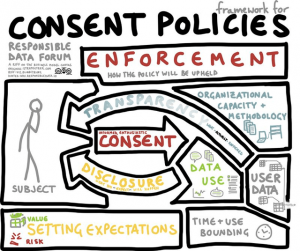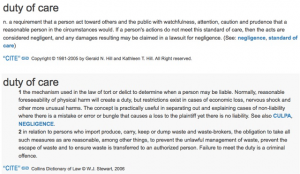Rethinking Informed Consent in Digital Development

Most INGOs have not updated their consent forms and policies for many years, yet the growing use of technology in our work, for many different purposes, raises many questions and insecurities that are difficult to address.
- Our old ways of requesting and managing consent need to be modernized to meet the new realities of digital data and the changing nature of data.
- Is informed consent even possible when data is digital and/or opened?
- Do we have any way of controlling what happens with that data once it is digital?
- How often are organizations violating national and global data privacy laws?
- Can technology be part of the answer?
At the MERL Tech conference, we looked at these issues in a breakout session on rethinking consent in the digital age.
What Is Consent?
Let’s take a moment to clarify what kind of consent we are talking about in this post. Being clear on this point is important because there are many synchronous conversations on consent in relation to technology.
For example there are people exploring the use of the consent frameworks or rhetoric in ICT user agreements – asking whether signing such user agreements can really be considered consent. There are others exploring the issue of consent for content distribution online, in particular personal or sensitive content such as private videos and photographs.
And while these (and other) consent debates are related and important to this post, what we are specifically talking about is how we, our organizations and projects, address the issue of consent when we are collecting and using data from those who participate in programs or monitoring, evaluation, research and learning (MERL) that we are implementing.
This is as timely as ever because introducing new technologies and kinds of data means we need to change how we build consent into project planning and implementation. In fact, it gives us an amazing opportunity to build consent into our projects in ways that our organizations may not have considered in the past.
While it used to be that informed consent was the domain of frontline research staff, the reality is that getting informed consent – where there is disclosure, voluntariness, comprehension and competence of the data subject – is the responsibility of anyone ‘touching’ the data.

Two Examples of Digital Consent
Over the past two years, Girl Effect has been incorporating a number of mobile and digital tools into its programs. These include both the Girl Effect Mobile (GEM) and the Technology Enabled Girl Ambassadors (TEGA) programs.
Girl Effect Mobile is a global digital platform that is active in 49 countries and 26 languages. It is being developed in partnership with Facebook’s Free Basics initiative. GEM aims to provide a platform that connects girls to vital information, entertaining content and to each other.
Girl Effect’s digital privacy, safety and security policy directs the organization to review and revise its terms and conditions to ensure that they are ‘girl-friendly’ and respond to local context and realities, and that in addition to protecting the organization (as many T&Cs are designed to do), they also protect girls and their rights.
The GEM terms and conditions were initially a standard T&C. They were too long to expect girls to look at them on a mobile, the language was legalese, and they seemed one-sided. So the organization developed a new T&C with simplified language and removed some of the legal clauses that were irrelevant to the various contexts in which GEM operates.
Consent language was added to cover polls and surveys, since Girl Effect uses the platform to conduct research and for it’s monitoring, evaluation and learning work. In addition, summary points are highlighted in a shorter version of the T&Cs with a link to the full T&Cs. Girl Effect also develops short articles about online safety, privacy and consent as part of the GEM content as a way of engaging girls with these ideas as well.
TEGA is a girl-operated mobile-enabled research tool currently operating in Northern Nigeria. It uses data-collection techniques and mobile technology to teach girls aged 18-24 how to collect meaningful, honest data about their world in real time. TEGA provides Girl Effect and partners with authentic peer-to-peer insights to inform their work.
Because Girl Effect was concerned that girls being interviewed may not understand the consent they were providing during the research process, they used the mobile platform to expand on the consent process. They added a feature where the TEGA girl researchers play an audio clip that explains the consent process. Afterwards, girls who are being interviewed answer multiple-choice follow up questions to show whether they have understood what they have agreed to.
(Note: The TEGA team report that they have incorporated additional consent features into TEGA based on examples and questions shared in our session).
Oxfam, in addition to developing out their Responsible Program Data Policy, has been exploring ways in which technology can help address contemporary consent challenges.
The organization had doubts on how much its informed consent statement (which explains who the organization is, what the research is about and why Oxfam is collecting data as well as asks whether the participant is willing to be interviewed) was understood and whether informed consent is really possible in the digital age.
All the same, the organization wanted to be sure that the consent information was being read out in its fullest by enumerators (the interviewers). There were questions about what the variation might be on this between enumerators as well as in different contexts and countries of operation.
To explore whether communities were hearing the consent statement fully, Oxfam is using mobile data collection with audio recordings in the local language and using speed violations to know whether the time spent on the consent page is sufficient, according to the length of the audio file played. This is by no means foolproof but what Oxfam has found so far is that the audio file is often not played in full and or not at all.
Efforts like these are only the beginning, but they help to develop a resource base and stimulate more conversations that can help organizations and specific projects think through consent in the digital age.
Additional resources include this framework for Consent Policies developed at a Responsible Data Forum gathering.
Other Digital Consent Ideas
Additionally, because of how quickly technology and data use is changing, one idea that was shared was that rather than using informed consent frameworks, organizations may want to consider defining and meeting a ‘duty of care’ around the use of the data they collect.

This can be somewhat accomplished by through the creation of organizational-level Responsible Data Policies. There are also interesting initiatives exploring new ways of enabling communities to define consent themselves – like this data licenses prototype.
The development and humanitarian sectors really needs to take notice, adapt and update their thinking constantly to keep up with technology shifts. We should also be doing more sharing about these experiences. By working together on these types of wicked challenges, we can advance without duplicating our efforts.
This post is co-authored by Emily Tomkys, Oxfam GB; Danna Ingleton, Amnesty International; and Linda Raftree, Independent.
You might also like
-
Join us on May 15th for an AI+Africa Working Group Meeting: Shaping Our Priorities!
-
Event Recap: Tests of Large and Small Language Models on Common Evaluation Tasks
-
Girl Effect Guidelines on Ethical AI-Powered Social & Behaviour Change Chatbots
-
Tech Salon recap: listen more and shift away from Western-centric framing to better address online violence against women and girls
